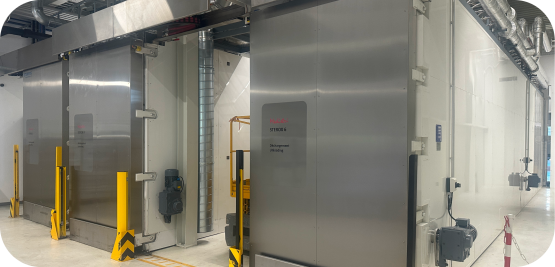Since the 1960s, Ethylene Oxide (EO) has been a globally recognized method to sterilize medical devices and pharmaceutical products. Its effectiveness lies in its ability to penetrate breathable packaging and reach all product surfaces, ensuring the necessary Sterility Assurance Level (SAL).
As an alkylating agent, EO disrupts the metabolic and reproductive functions of microorganisms. This makes it highly effective against bacteria, viruses, and fungi, ensuring medical devices are safe for patient use worldwide.
Addressing Environmental & Safety Challenges
While EO remains essential for healthcare, its use requires careful attention to human safety and environmental responsibility. At Medistri, we believe that regulatory compliance is only a starting point. That’s why we invest in systems that go beyond local and federal requirements, ensuring the health of our communities and future generations.
Our EO infrastructure is equipped with advanced, high-performance gas treatment technology. Using a two-step process, residual EO passes first through a Peak Shaver to reduce concentration, followed by a Catalytic Burner that eliminates the remaining gas. This system allows for an almost complete reduction of EO emissions, positioning Medistri as a leader in sustainable sterilization technology.
Our EO Sterilization Infrastructure
Medistri operates one of Europe’s largest independent EO sterilization capacities:
- Switzerland (Domdidier): 6 sterilization chambers with capacity for loads up to 200 cm in height. This allows customers to maximize production load sizes and reduce costs. Our Swiss site currently processes more than 90,000 pallets annually.
- Hungary (Székesfehérvár): 1 sterilization chamber integrated within our second site, expanding Medistri’s dual-site capabilities and ensuring greater resilience for our partners.
Together, these facilities position Medistri as a strategic partner able to provide both high capacity and cross-site flexibility for manufacturers across Europe.
Smarter Validation Approaches
At Medistri, we are not only advancing EO sterilization technology, but also transforming the way sterilization cycles are validated. Traditional methods, while widely used, create unnecessary inefficiencies and environmental burdens. That’s why we have implemented a more advanced and sustainable alternative: the Biological Indicator / Bioburden Approach.
Limitations of the Traditional Overkill Method
- Uses excessive EO gas, creating unnecessary emissions.
- Requires very long cycles, often 20+ hours with aeration.
- Increases production bottlenecks and delays product release.
- Drives higher operational costs across the supply chain.
The Medistri Solution: Biological Indicator/ Bioburden Approach
- Uses less EO gas, reducing residues and environmental impact.
- Shorter cycles allow faster product release.
- Sustainable approach aligned with modern industry needs.
- Reflects real manufacturing conditions and worst-case scenarios.
- May require more cycles initially, but delivers long-term efficiency and cost savings.
By adopting the Bioburden Approach, Medistri provides its partners with a validation strategy that is cleaner and more sustainable, while remaining fully compliant with ISO 11135. This approach reduces complexity for manufacturers, ensures patient safety, and represents a decisive step forward compared to the traditional Overkill method.
Shaping the Future of EO Sterilization
At Medistri, innovation means continuously optimizing technologies, reducing environmental impact, and ensuring patient safety. By combining advanced emission control, smarter validation approaches, and large-scale infrastructure, we help our partners accelerate projects while meeting the highest standards of safety and sustainability.
Learn more about Medistri’s EO Sterilization Technology on our website here or contact our team at contact@medistri.com.
— The Medistri Team
1. What makes Ethylene Oxide (EO) a preferred sterilization method for medical devices?
EO is highly effective because it penetrates breathable packaging and reaches all product surfaces, ensuring microorganisms are fully inactivated. Its broad-spectrum action against bacteria, viruses, and fungi has made it a standard in the healthcare and pharmaceutical industries since the 1960s.
2. Why is environmental control important in EO sterilization?
EO is an effective but potentially hazardous gas, so managing emissions is critical for protecting human health and the environment. Advanced treatment systems, such as catalytic burners, ensure residual EO is almost entirely removed before release.
3. How does the Bioburden Approach differ from the traditional Overkill Method?
The Bioburden Approach uses actual microbial data and biological indicators to validate sterilization, while the Overkill Method relies on applying excessive EO gas. This modern approach reduces gas consumption, shortens cycles, and better reflects real manufacturing conditions.
4. When should manufacturers consider alternative validation strategies for EO sterilization?
Manufacturers should evaluate alternatives when seeking to reduce environmental impact, improve cycle efficiency, or align with evolving regulatory expectations. Adopting approaches like the Bioburden Method can help balance sustainability with compliance and patient safety.
5. How does Medistri support manufacturers in EO sterilization and validation?
Medistri combines large-scale EO infrastructure with sustainable validation strategies aligned to ISO 11135. By integrating emission control systems and smarter approaches like the Bioburden Method, Medistri provides manufacturers with reliable, efficient, and environmentally responsible sterilization solutions.
